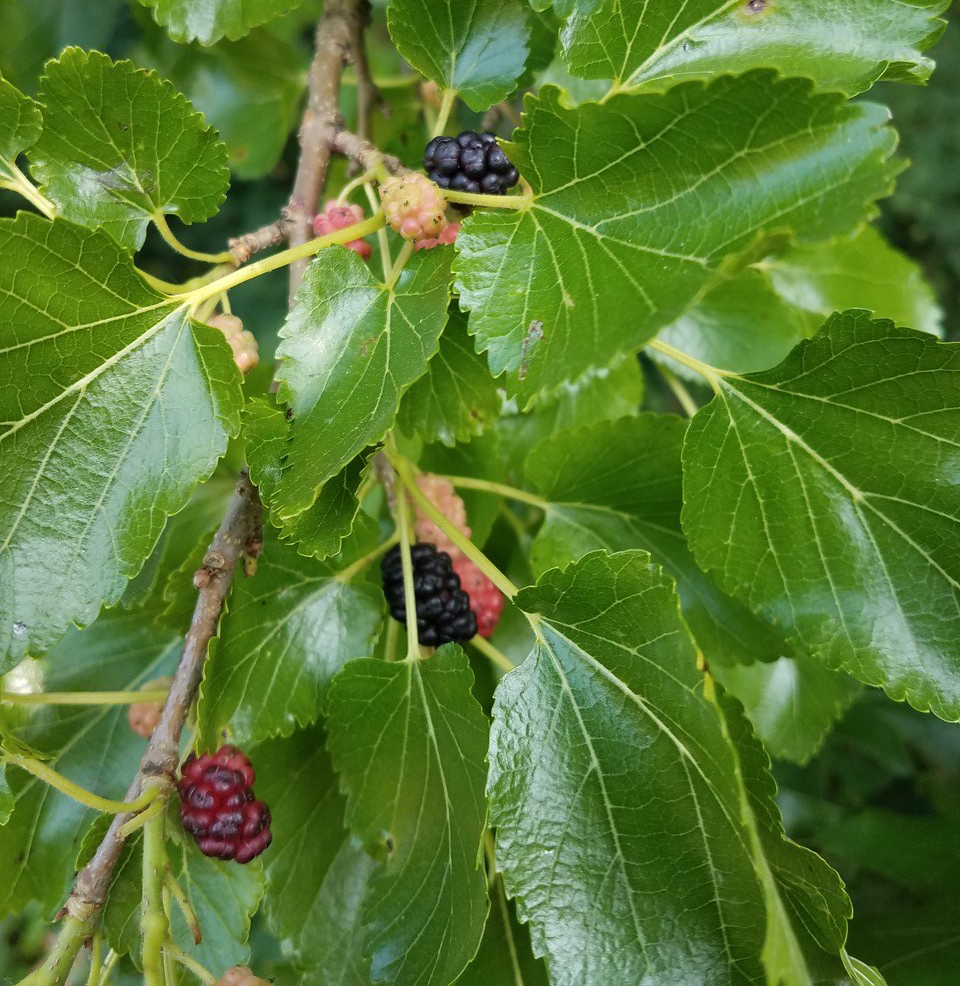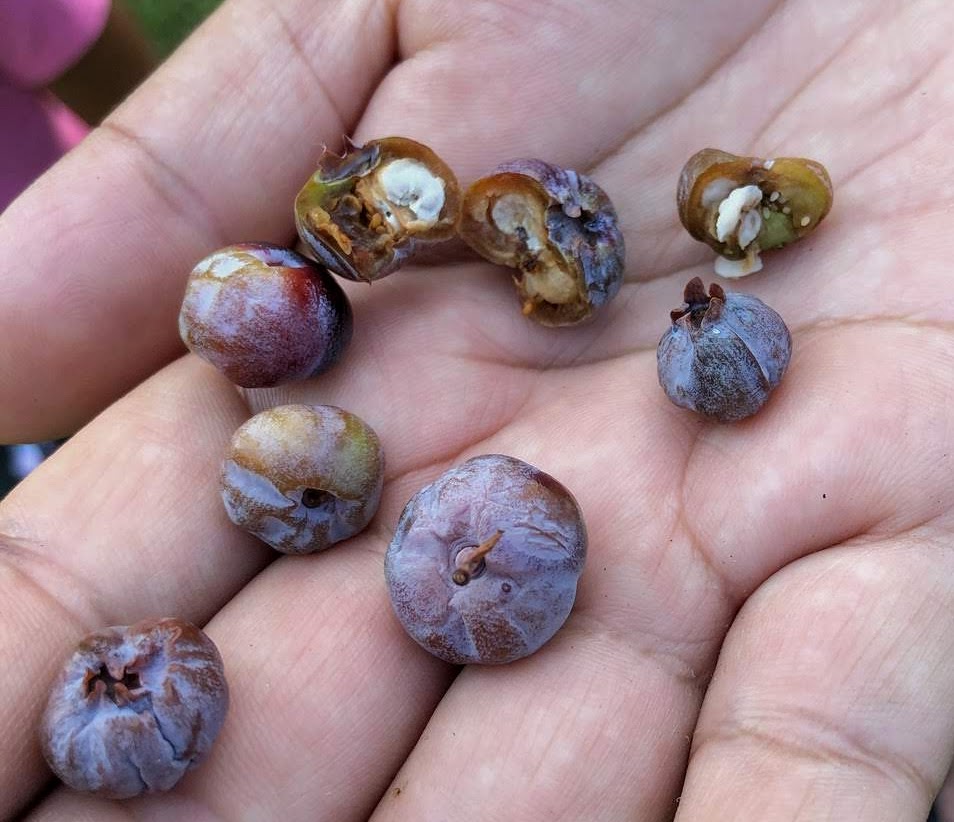Southwest Michigan fruit update – July 9, 2019
Summer fruit harvest is well underway with blueberries, cherries and raspberries.

Weather
Last week’s weather was hot and humid. High temperatures were in the upper 80s with some stations reading 90 degrees on Tuesday, July 2. Lows were generally in the upper 60s with Friday morning remaining above 70. Precipitation last week was spotty. Scattered storm moved across the region beginning Wednesday continuing through Saturday Locations along Lake Michigan saw no rain, but some inland areas received over 2 inches. Rainfall totals for the season range from 12 to 18 inches across the region since April 1.
The forecast for this coming week is for more moderate conditions, with highs in the mid-80s and lows in the 60s. The best chances of rain are late Wednesday. Soils are drying out. Some irrigation is being used in young plantings. With the hot temperatures, we picked up a lot of heat units, 220 GDD base 42 and 164 GDD base 50.
|
Southwest Michigan GDD summary from March 1 - July 8, 2019 | |||
|---|---|---|---|
|
Station |
GDD 42 F |
GDD 45 F |
GDD 50 F |
|
Benton Harbor (SWMRC) |
1674 |
1407 |
1022 |
|
Lawton (Lawton) |
1727 |
1410 |
1028 |
|
Fennville (TNRC) |
1527 |
1272 |
909 |
|
Average for the SW region |
1693 |
1426 |
1040 |
|
Accumulation last week |
267 |
243 |
197 |
A note for those that have been using information from the Benton Harbor (Southwest Michigan Research and Extension Center) Enviroweather station: The leaf wetness sensor was replaced this past week. The sensor has been malfunctioning for the majority of the spring. If you need any historical leaf wetness numbers for this past spring, look to data from the next closest weather station to you.
Check out the new animated weather forecasts from Jeff Andresen at the weather tab in the Michigan State University Extension Fruit & Nuts Page. Articles and other regional reports can be found at the Fruit News page.
Tree fruit

First catch and biofix for first generation oriental fruit moth was on May 6 (165 GDD base 45) at the Trevor Nichols Research Center. The second generation flight of oriental fruit moth should be underway. The second and third generation flights are less distinct than the first. First trap catch and biofix of obliquebanded leafroller was June 14, with egg hatch estimated to be underway. San Jose scale crawlers have been hatching over the past three weeks. Brown marmorated stink bug activity has been increasing, but summer adults will not show up in large numbers for a while. Japanese beetle adults are becoming easier to find. Asiatic garden beetle feeding damage is being seen on foliage of peach trees planted this year. The small brown beetles hide in the upper soil layer during the day and feeds on foliage during the night.
In peach and nectarine trees, shoot flagging and fruit entry by oriental fruit moth larvae can be found. This coming week’s heat will put additional stress on winter damaged trunks and weakened trees are especially attractive to borers. Protect trunks with insecticide sprays soon. Bacterial spot symptoms are becoming easier to see, with leaves yellowing and dropping.
Cherries are harvested. Both sweet cherry and tart cherry harvest are underway. Cherry leaf spot symptoms have become very easy to see in tart orchards. Cherry leaves are always susceptible to leaf spot, so management is needed to maintain a healthy leaf canopy during the entire season. Some leaf drop is due to bacterial canker infections from earlier in the season. There is no treatment for bacterial canker now and the disease will not spread. Ripe and ripening cherries are attractive to spotted wing Drosophila (SWD). We expect SWD fly numbers to increase as many wild fruits such as black raspberry, mulberry and bush honeysuckle are available for colonization.
Trap catch of cherry fruit fly has been at low levels over the past three weeks. New obliquebanded leafroller larvae may be feeding now on foliage in cherry trees now and can be harvested along with the cherry crop. You may need to apply insecticides to control these insect pests.
The plum crop is light. Obliquebanded leafroller and codling moth damage to fruit will be a greater risk in July as larvae hatch and grow larger.
Apple fruit are growing rapidly and hand-thinning is still underway. Shoot and foliage growth has been lush and excessive foliage growth increases the potential for bitter pit in apple varieties prone to this disorder. Fire blight infections are appearing now. At this stage with only a few infections in the orchards, cutting out the infection is a good way to go. If you have scab lesions on leaves and fruit, include fungicides in your upcoming cover sprays. Unsprayed apples and crabapple have very high levels of scab and are defoliating. The Enviroweather sooty blotch and flyspeck model indicates that spray applications for these diseases may be necessary. Codling moth larval entry into fruit is possible now that the larvae are hatching.
Pear fruit are sizing rapidly and hand-thinning is still underway. The time of rapid shoot growth with succulent leaves is the primary treatment window for pear psylla. The first generation codling moth is not a problem in hard pears but plum curculio can and will lay eggs in pears.
Small fruit
.jpg)
Japanese beetles have emerged. We are catching some spotted wing Drosophila (SWD). Trap catch numbers rose last week. We expect numbers to increase soon, since bush honeysuckle has lots of ripe fruit. Place traps near early ripening wild fruit so you have an idea of the local population. Monitor your fields and wild fruit near your field and be prepared to spray to protect ripening fruit. See “Plan to change when dealing with spotted wing Drosophila” for more information.
Grapes have buckshot sized berries in wine grapes. Juice grapes are nearing cluster tightening or berry touch. Post bloom sprays are important to control diseases on grape berries. Use materials or a mix of fungicides to control all the major grape diseases, downy mildew, phomopsis, powdery mildew and black rot, which can infect rapidly growing green berries. Downy mildew, black rot leaf lesions and phomopsis on the leaves and stems can be found in vineyards now.
Apple grape berry moth sprays now. Bloom in wild grapes is used to set the grape berry moth model on Enviroweather and determine the spray timing for treating the second and third generations. Wild grape bloom began about May 31 in central Berrien County and June 1 in Van Buren County. Controls are targeted for 810 GDD50 after bloom in wild grapes. We are currently at about 800 and insecticidal sprays for the second generation should be applied.

Blueberries have green fruit and harvest of early varieties such as Bluetta and Duke has begun. The crop varies quite a bit from field to field. Mummy berry fruit symptoms have begun to appear. There is no treatment at this time since the fruit infection occurs during bloom.
Blueberry maggot adults have been trapped and protectant sprays should be applied. SWD numbers are increasing. Most of our SWD traps are catching flies so growers who are not trapping their fields to monitor SWD should be protecting their fruit.
Strawberry harvest from matted row plantings has ended. Begin renovating fields immediately after the end of harvest. See “Strawberry renovation is due soon” for more information.
Raspberry and black raspberry harvest has begun. Japanese beetles are out and feed on raspberries. Raspberries and blackberries are very attractive to SWD and fruit needs to be protected from this pest.



 Print
Print Email
Email
